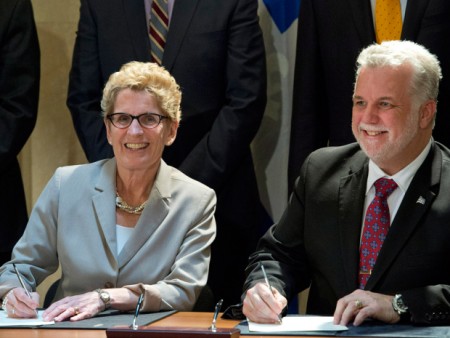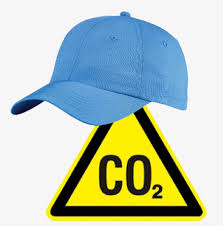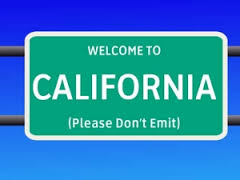April 15, 2015 – A few days ago, Canada’s Environment Minister, Leona Aglukkaq, chided Canadian provincial leaders for not submitting carbon reduction strategies to the federal government so that it could submit an emission-reduction commitment to the United Nations. Talk about dereliction of responsibility. Canada’s federal government passing the blame to lesser jurisdictions rather than taking a leadership role in coordinating a national response to climate change challenges.
This “coordinating approach” is the latest way for Canada’s Conservative government to dodge the bullet, and insulting to the intelligence of all Canadians. Meanwhile the current federal Finance Minister, Joe Oliver, a former Natural Resources Minister, has made it pointedly clear that he believes climate change science is misleading or has yet to read a report that indicates the future risk of rising greenhouse gas emissions. He like Canada’s Prime Minister, Stephen Harper, has traded on fear and uncertainty re jobs should government put a price on carbon. The Prime Minister has referred to pricing carbon as a “job-killing carbon tax.” Oliver, his Finance Minister, recently stated his objections. Here are his words:
“Head down the path of economic decline, higher unemployment, limited funds for social programs like health care, continuing deficits and growing debt, or achieve prosperity and security now and for future generations through the responsible development of our resources.”
In other news this week, Canada’s largest province, Ontario, joined with the existing California and Quebec carbon-cap-and-trade community increasing this trade area to incorporate approximately one-sixth of the continent’s population. Through a system of enforced declining caps for a variety of greenhouse and ozone-limiting gases industry will find efficiencies or buy credits from others to ensure that overall emissions decline over time. The value of those credits, some given away for free at the beginning, will rise as governments lower the cap. The end goal – to create enough disincentive for utilities and whole industries to lower the greenhouse gases they produce. Ontario’s government has, as of yet, to set its caps in joining the program. We should see the system in place by late summer.
Although the press in Canada and the official voice of the United Nations hailed the announcement of cap-and-trade in Ontario as a significant step in battling climate change, cap-and-trade as a mechanism for carbon reduction is by no means a sure thing.
The history of cap-and-trade so far is mixed. The first success known as the Montreal Protocol was implemented in 1989, driven by the United States government under President George H. W. Bush (yes a Republican) to address industrial use of chlorofluorocarbons causing depletion of the ozone layer. It was hailed a success although we are still seeing ozone thinning despite the fact that chlorofluorocarbon production worldwide has experienced a steep decline. Scientists are only now realizing how durable and pervasive chlorofluorocarbons are. The hope is by mid century the ozone layer will start to see a reversal. Heed this as a warning that changes we make in the present may take a considerable amount of time before we see positive feedback in the environment.
The second iteration of cap-and-trade, this time addressing greenhouse gases happened in 2005 when the European Union and European Free Trade Area instituted a system covering primary greenhouse gas emissions (carbon dioxide and nitrous oxide) coming from 11,000 power stations and industrial plants, as well as aircraft operators in 31 countries. Initially each country set its own cap. But in 2013 the Union moved to a single cap for the entire area. Carbon credits were given away at the start but today they are sold at auction. The price on carbon has varied over time, waxing and waning with every economic up and downturn and every political speech made by European leaders. This presents a problem. Current carbon pricing is around 6 euros per ton. That is a disincentive to most industry to find reduction savings. Economic optimists, however, predict a rise to as much as 23 euros per ton by 2021 while others predict the value of carbon to drop to as low as 4 euros. At 23 euros per ton greenhouse gas producers will find motivation to decrease greenhouse gas emissions. But at 4 euros per ton they will sit on their hands in terms of making any carbon reduction improvements to their infrastructure. They’ll just pay the carbon tax.
And then finally there is another aspect of the Union’s program that is troubling. Only 45% of greenhouse gas emissions are actually governed by its cap-and-trade provisions. Whole industries are exempted. Small emitters as well. So it is a wonder that the Union has seen overall reductions in greenhouse gas emissions with 2013 producing a decline of 3%. The stated goal, however, remains a 40% reduction in greenhouse gas emissions by 2030 based on 1990 levels. If carbon credits remain as depressed as they currently are, the Union has little chance of hitting that more ambitious number.
The third cap-and-trade program was launched in California beginning in January 2013. Its coverage on gases is more comprehensive including carbon dioxide, methane, nitrous oxide, perfluorocarbons, sulfur hexaflouride, and nitrogen triflouride gas. Emitters producing 25,000 metric tons annually are subject to cap-and-trade restrictions. So smaller emitters are exempted. The initial system provides free credits to power utilities and other select industries but those freebies decline over time. The stated goal – to see reductions of 15% between 2015 and 2020. This is the system that Quebec joined last year and Ontario joined this week.
In a meeting of Canadian provincial leaders this week in Quebec City, the premier of Saskatchewan, Brad Wall, pointed out that Canada only produces 2% of all global greenhouse gas emissions, describing our role in climate change as marginal. He went on to state that Canada’s priority should not focus on carbon pricing but on carbon sequestration to help the rest of the world clean up its coal-fired power plants. Wall is looking to sell the technology implemented at the Boundary Dam, the first operational, large-scale carbon sequestration project in North America.
What Wall failed to mention is that Canada is the world’s ninth largest carbon emitter which would suggest that we need to clean up our own house as well as help the rest of the world address reducing its carbon footprint.
At the premier’s meeting, the leader of Alberta was among the missing (an election is underway). Alberta is the source of most of Canada’s industrial greenhouse gas emissions today because of the intensive nature of oil sands extraction processes. The province instituted a nominal carbon tax on large energy emitters but greenhouse gas emission levels are expected to continue to increase between now and 2020.
Canada remains a wayward son in addressing carbon reductions. With no commitment from leadership at the federal level it looks like municipalities and provinces will take the lead. The picture below is of Ontario and Quebec’s premiers signing their commitment to reduce carbon. Maybe this is the picture of our future with governments closer to the problem source prepared to make the tough decisions to save us from ourselves so that the generations that follow will experience no less a quality of life than those living today.













